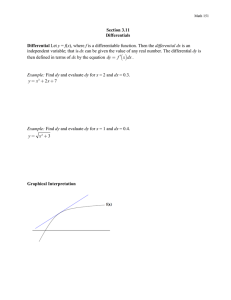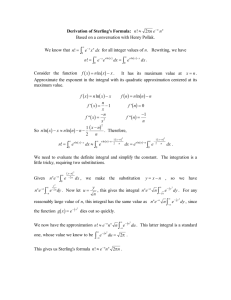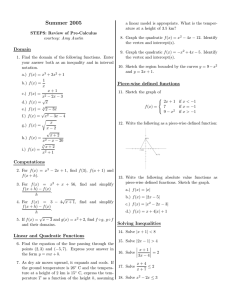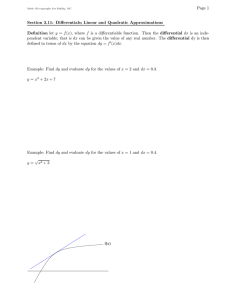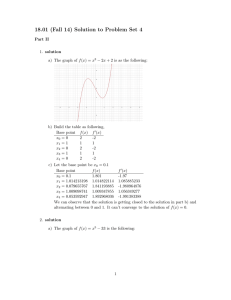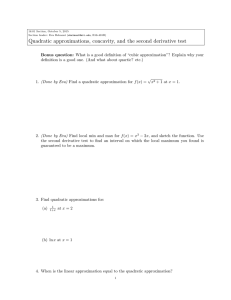2. Applications of Differentiation 2A. Approximation
advertisement
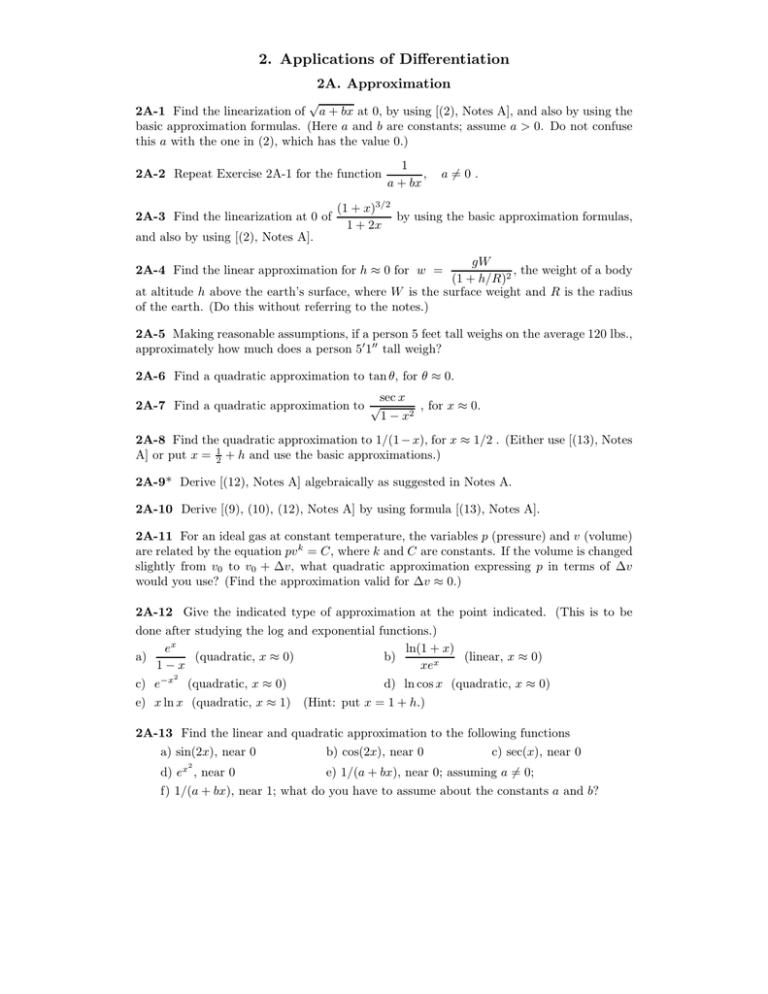
2. Applications of Differentiation 2A. Approximation √ 2A-1 Find the linearization of a + bx at 0, by using [(2), Notes A], and also by using the basic approximation formulas. (Here a and b are constants; assume a > 0. Do not confuse this a with the one in (2), which has the value 0.) 2A-2 Repeat Exercise 2A-1 for the function 2A-3 Find the linearization at 0 of and also by using [(2), Notes A]. 1 , a + bx a 6= 0 . (1 + x)3/2 by using the basic approximation formulas, 1 + 2x gW , the weight of a body (1 + h/R)2 at altitude h above the earth’s surface, where W is the surface weight and R is the radius of the earth. (Do this without referring to the notes.) 2A-4 Find the linear approximation for h ≈ 0 for w = 2A-5 Making reasonable assumptions, if a person 5 feet tall weighs on the average 120 lbs., approximately how much does a person 5′ 1′′ tall weigh? 2A-6 Find a quadratic approximation to tan θ, for θ ≈ 0. sec x , for x ≈ 0. 2A-7 Find a quadratic approximation to √ 1 − x2 2A-8 Find the quadratic approximation to 1/(1 − x), for x ≈ 1/2 . (Either use [(13), Notes A] or put x = 21 + h and use the basic approximations.) 2A-9* Derive [(12), Notes A] algebraically as suggested in Notes A. 2A-10 Derive [(9), (10), (12), Notes A] by using formula [(13), Notes A]. 2A-11 For an ideal gas at constant temperature, the variables p (pressure) and v (volume) are related by the equation pv k = C, where k and C are constants. If the volume is changed slightly from v0 to v0 + ∆v, what quadratic approximation expressing p in terms of ∆v would you use? (Find the approximation valid for ∆v ≈ 0.) 2A-12 Give the indicated type of approximation at the point indicated. (This is to be done after studying the log and exponential functions.) ln(1 + x) ex (linear, x ≈ 0) (quadratic, x ≈ 0) b) a) 1−x xex 2 c) e−x (quadratic, x ≈ 0) d) ln cos x (quadratic, x ≈ 0) e) x ln x (quadratic, x ≈ 1) (Hint: put x = 1 + h.) 2A-13 Find the linear and quadratic approximation to the following functions a) sin(2x), near 0 x2 d) e , near 0 b) cos(2x), near 0 c) sec(x), near 0 e) 1/(a + bx), near 0; assuming a 6= 0; f) 1/(a + bx), near 1; what do you have to assume about the constants a and b? E. 18.01 EXERCISES 2A-14* Suppose that a piece of bubble gum has volume 4 cubic centimeters. a) Use a linear approximation to calculate the thickness of a bubble of inner radius 10 centimeters. (Start with the relation between the volume V of a sphere and the radius r, and derive the approximate relation between ∆V and ∆r.) b) Find the exact answer. c) To how many significant figures is the linear approximation accurate? In other words, find the order of magnitude of the difference between the approximation and the exact answer. (Be sure you use enough digits of π to reflect correctly this accuracy!) d) Use a quadratic approximation to the exact formula for the thickness that you found in part (b) to get an even more accurate estimate. e) Why is the quadratic term comparable to the error in the accuracy of the linear approximation? 2A-15 Find the linear and quadratic approximations to cos(3x) near x = 0, π/6, and π/3. p 2A-16 a) Use the law of cosines to find the formula 2 − cos(2π/n) for the length of the side of the equilateral n-gon inscribed in the unit circle. b) Compute the perimeter and then compute the limit as n tends to infinity using the quadratic approximation to cos θ near θ = 0. (Compare with 1J-4.) 2B. Curve Sketching 2B-1 Sketch the graphs of the following. Find the intervals on which it is increasing and decreasing and decide how many solutions there are to y = 0. (Graphs need not reflect inflection points, which are discussed in 9-2). a) y = x3 − 3x + 1 c) y ′ (x) = 1/(1 + x2 ) and y(0) = 0. e) y = x/(x + 4) g) y = 3x4 − 16x3 + 18x2 + 1 b) y = x4 − 4x + 1 d) y = x2 /(x − 1) √ f) y = x + 1/(x − 3) h) y = e−x 2 2 i) y ′ = e−x and y(0) = 0. 2B-2 Find the inflection points of the graphs in problem 1. 2B-3 Find the conditions on a, b and c for which the cubic y = x3 + ax2 + bx + c has a local maximum and a local minimum. Use the following two methods: a) Find the condition under which y ′ has two distinct real roots. Which of these roots is at the local maximum and which is at the local minimum? (Draw a picture.) b) Find the condition under which y ′ < 0 at the inflection point. Why does this property imply that there is a local maximum and a local minimum? 2B-4 Suppose that f is a continuous function on 0 ≤ x ≤ 10. Sketch the graph from the following description: f is zero at 4, 7, and 9. f ′ (x) > 0 on 0 < x < 5 and 8 < x < 10 2. APPLICATIONS OF DIFFERENTIATION and f ′ (x) < 0 on 5 < x < 8. With the given information, can you say anything for certain about the maximum value, the minimum value of f ? Can you say anything about the place where the maximum is attained or the place where the minimum is attained? 2B-5 a) Trace a copy of the graph of the function below and draw the graph of the derivative directly underneath. Connect the inflection point to the corresponding point on the graph of the derivative with a vertical dotted line. b) Find a rational function with a graph resembling the one below. -7 -3 -1 5 2B-6 a) Find a cubic polynomial with a local maximum at x = −1 and a local minimum at x = 1. b) Draw the graph of the cubic on −3 ≤ x ≤ 3. c) Draw a differentiable function on −3 ≤ x ≤ 3 that has an absolute maximum at x = −1 and an absolute minimum at x = 1. 2B-7 a) Prove that if f (x) is increasing and it has a derivative at a, then f ′ (a) ≥ 0. (You may use the fact that a positive function has a limit ≥ 0.) b) If the conclusion of part (a) is changed to : f ′ (a) > 0, the statement becomes false. Indicate why the proof of part (a) fails to show that f ′ (a) > 0, and give a counterexample to the conclusion f ′ (a) > 0 (i.e., an example for which it is false). c) Prove that if f (x) has relative maximum at a and it has a derivative at a, then f ′ (a) = 0. (Consider the right-and left-hand limits of ∆y/∆x; apply the ideas of part (a).) 2C. Max-min problems 2C-1 Cut four identical squares out of the corners of a 12 by 12 inch piece of cardboard and fold the sides so as to make a box without a top. Find the size of the corner square that maximizes the volume of the box. 2C-2 You are asked to design a rectangular barnyard enclosing 20,000 square feet with fencing on three sides and the wall of a long barn on the fourth. Find the shortest length of fence needed. 2C-3 What is the largest value of the product xy, if x and y are related by x + 2y = a, where a is a fixed positive constant? E. 18.01 EXERCISES 2C-4 The U. S. Postal Service accepts boxes whose length plus girth equals at most 108 inches. What are the dimensions of the box of largest volume that is accepted? What is its volume (in cubic feet)? (“Length” is the longest of the three dimensions and “girth” is the sum of the lengths of the four sides of the face perpendicular to the length, that is, the “waist-line” measurement of the box. Note that the best shape for this rectangular face perpendicular to the length must be a square.) 2C-5 Find the proportions of the open (i.e., topless) cylindrical can having the largest volume inside, among all those having a fixed surface area A. (Use as the variable the radius r.) 2C-6 What are the largest and the smallest possible values taken on by the product of three distinct numbers spaced so the central number x has distance 1 from each of the other two, if x lies between −2 and 2 inclusive? 2C-7 Find the dimensions of the rectangle of largest area that can be inscribed in a semicircle of radius a. 2C-8 Find the dimensions of the rectangle of largest area in a right triangle, if a) the sides of the rectangle are parallel to the legs; b) one side of the rectangle is parallel to the hypotenuse. (Of the two placements, which gives the rectangle of larger area?) 2C-9 A light ray reflected in a mirror travels the shortest distance between its starting point and its endpoint. Suppose the ray starts at (0, 1), and ends at the point (a, b) inside the first quadrant, and being reflected when it hits the x-axis (at the point (x, 0), say). Show that the two line segments forming its path make equal angles with the x-axis, i.e., “the angle of incidence equals the angle of reflection.” 2C-10 A swimmer is on the beach at a point A. The closest point on the straight shoreline to A is called P . There is a platform in the water at B, P β and the nearest pont on the shoreline to B is called Q. x a x Suppose that the distance from A to P is 100 meters, the α distance from B to Q is 100 meters and the distance from 100 P to Q is a meters. Finally suppose that the swimmer can run at 5 meters per second on the beach and swim at 2 A meters per second in the water. Show that the path the swimmer should take to get to the platform in the least time has the property that the ratio of the sines of the angles the path makes with the shoreline is the reciprocal of the ratio of the speeds in the two regions: 5 sin α = sin β 2 (In optics, this is known as Snell’s law describing the path taken by a light ray through two successive media. Snell discovered experimentally that the above ratio of sines was a constant, not depending on the starting point and endpoint of the path. This problem shows that Snell’s law follows from a minimum principle: the light ray takes the path minimizing its total travel time. The ratio of sines is constant since it depends only on the speeds of light in the two media.) B 100 Q 2. APPLICATIONS OF DIFFERENTIATION 2C-11 A beam with a rectangular cross-section is cut from a log with a circular crosssection. The strength S of the beam is proportional to the horizontal dimension x of the rectangle and to the cube of the vertical dimension y of the rectangle, S = cxy 3 . Find the ratio y/x which gives the strongest beam. 2C-12 You are going to mount a light on the wall behind your desk. The light at S S illuminates a point P on the horizontal surface of the desk with an intensity inversely proportional to the square of the distance from P to S and proportional to sine of the angle between the ray from P to S and the horizontal surface. Fix a point P on the desk 1 foot from the wall. Find the height of S above the desk for which θ 1 P the intensity at P is largest. 2C-13 a) An airline will fill 100 seats of its aircraft at a fare of $200. For every $5 increase in the fare, the plane loses two passengers. For every decrease of $5, the company gains two passengers. What price maximizes revenue? b) A utility company has a small power plant that can produce x kilowatt hours of electricity daily at a cost of 10 − x/105 cents each for 0 ≤ x ≤ 8 × 105 . Consumers will use 105 (10 − p/2) kilowatt hours of electricity daily at a price of p cents per kilowatt hour. What price should the utility charge to maximize its profit? 2C-14 Find the maximum value and the location of the maximum for the following functions. (When a > 0, xa ln x → 0 as x → 0+ . This follows from 2G-8 or from L’Hospital’s rule in Section 6A.) a) x2 ln(1/x), for x > 0 b) −x ln(2x), for x > 0 2C-15 Find the minimum of (x + 1)e−x , for 0 ≤ x < ∞. 2D. More Max-min Problems 2D-1* Consider a supersonic airplane wing with a cross-section in the shape of a thin diamond (rhombus) in which the half-angle of the opening is τ and the attack angle α. (The attack angle is the angle that the long diagonal of the rhombus makes with the horizontal direction of motion of α=τ the plane. See the picture.) The ratio of the lift to the drag is given by the formula (from the Course 16 Unified direction of plane Engineering notes on aerodynamics): α lift = 2 drag α + τ2 a) For a given fixed τ , find the best attack angle α, that is, the one the maximizes the ratio of lift to drag. b) Find the minimum (largest negative) ratio. (This attack angle could be used in the design of a winged car attempting to break the sound barrier, to prevent it from flying.) 2D-2* Consider a paper cup in the shape of a cone obtained by rotating the line segment y = ax, 0 ≤ x ≤ r, around the y axis. For which slope a ≥ 0 will the paper cup hold the most water, assuming its surface area A is held fixed. √ (Use the formulas: volume V = 13 (area of the base)(height); A = πr2 1 + a2 .) E. 18.01 EXERCISES 2D-3 Coffee in a cup at a temperature y(t0 ) at time t0 in a room at temperature a cools according to the formula (derived in 3F-4); assume a = 20◦ C and c = 1/10: y(t) = (y(t0 ) − a)e−c(t−t0 ) + a, t ≥ t0 You are going to add milk so that the cup has 10% milk and 90% coffee. If the coffee has 1 9 T1 + 10 T2 . temperature T1 and the milk T2 , the temperature of the mixture will be 10 ◦ The coffee temperature is 100 C at time t = 0, and you will drink the mixture at time t = 10. The milk is refrigerated at 5◦ C. What is the best moment to add the milk so that the coffee will be hottest when you drink it? 2D-4* a) Show that the shortest collection of roads joining four towns at the four corners of a square of side 1 is given by roads that meet at 120◦ angles. Use the variable x representing the length of the shorter dashed leg of the right triangle indicated in the left-hand picture. (The right-hand one tells you what value you should find for x.) b) Solve the same problem, but for towns at the corners of a rectangle. Use a for its vertical height and 1 for its horizontal length, and x as in part (a). Write down the formula for the length of the roads as a function of a. Hint: The answer is that for minimum total length, the roads should meet at 120◦ angles, if a lies in a certain interval of positive real numbers; if a is outside this interval, the pattern formed by the roads is simpler. 1/2 x 1-2x 1 2 /3 60 o x 2D-5* Find the triangle of smallest area in the half-plane to the right of the y-axis whose three sides are respectively segments of the x-axis, the diagonal y = x, and a line through (2, 1). 2D-6* Find the point of the ellipse 73x2 − 72xy + 52y 2 = 2500 closest to (0, 0). Hint: Use implicit differentiation to find a quadratic equation in x and y. This is the type of equation (known as a homogeneous equation) that you faced in Problem 2C-11. The homogeneous form makes it possible to solve for y/x. You can then find (x, y) by substituting in the original equation. 2D-7* Find two positive numbers whose product is 10 and whose sum is as large as possible. 2E. Related Rates 2E-1 A robot going 20 ft/sec passes under a street light that is 30 feet above the ground. If the robot is 5 feet tall, how fast is the tip of its shadow moving two seconds after passing under the street light? How fast is the length of the shadow increasing at that moment? 2. APPLICATIONS OF DIFFERENTIATION 2E-2 A beacon light 4 miles offshore (measured perpendicularly from a straight shoreline) is rotating at 3 revolutions per minute. How fast is the spot of light on the shoreline moving when the beam makes an angle of 60◦ with the shoreline? 2E-3 Two boats are travelling at 30 miles/hr, the first going north and the second going east. The second crosses the path of the first 10 minutes after the first one was there. At what rate is their distance increasing when the second has gone 10 miles beyond the crossing point? 2E-4 Sand is pouring on a conical pile at a rate of 12 m3 per minute, in such a way that the diameter of the base of the pile is always 3/2 the height. Find the rate at which the height is increasing when the pile is 2 m tall. 2E-5 A person walks away from a pulley pulling a rope slung over it. The rope is being held at a height 10 feet below the pulley. Suppose that the weight at the opposite end of the rope is rising at 4 feet per second. At what rate is the person walking when s/he is 20 feet from being directly under the pulley? 2E-6 An airplane passes directly over a boat at a height of 2 miles. The plane is going north at 400 mph and does not change its altitude. The boat is going west at 50 mph. How rapidly is their distance from each other increasing after one hour? 2E-7 A trough is filled with water at a rate of 1 cubic meter per second. The trough has a trapezoidal cross section with the lower base of length half a meter and one meter sides opening outwards at an angle of 45◦ from the base. The length of the trough is 4 meters. What is the rate at which the water level h is rising when h is one half meter? 2E-8 One ship is sailing east at 60km an hour and another is sailing south at 50km an hour. The slower ship crosses the path of the faster ship at noon when the faster ship was there one hour earlier. Find the time at which the two ships were closest to each other. 2E-9 A girl slides down a slide in the shape of the parabola y = (x − 1)2 for 0 ≤ x ≤ 1. Her vertical speed is dy/dt = −y(1 − y). Find her horizontal speed dx/dt when y = 1/2. 2E-10 Oil spreads on a frying pan so that its radius is proportional to t1/2 , where t represents the time from the moment when the oil is poured. Find the rate of change dT /dt of the thickness T of the oil. 2F. Locating zeros; Newton’s method 2F-1 a) Graph the function y = cos x − x. Show using y ′ that there is exactly one root to the equation cos x = x, and give upper and lower bounds on the root. b) Use Newton’s method to find the root to 3 decimal places. c) Another way to find the root of cos x = x is to use what is called the fixed point method. Starting with the value z1 = 1, press the cosine key on your calculator until the answer stabilizes, i.e., until zn+1 = cos zn . How many iterations do you need until the first nine digits stabilize? Which method takes fewer steps? 2F-2 Graph the function y = 2x − 4 + 1 (x − 1)2 −∞<x<∞ E. 18.01 EXERCISES In particular, count how many times y vanishes. (In math jargon, “vanishes” means y = 0, not y → ∞. Another name for the values of x at which y = 0 is “the zeros” of y.) Give reasons, based on the sign of y ′ , that the zeros you have found must be there and that there cannot be any more. (For example, “There must be exactly one zero in the interval (−∞, −1) because . . . .”) 2F-3 Same problem as 2 for y = x2 + x−1 2F-4 The equation x5 − x = x(x2 − 1)(x2 + 1) = 0 has three roots, x = 0, 1, −1. How many roots does the equation x5 − x − 1/2 = 0 have? 2F-5 a) Find an initial value x1 for the zero of x − x3 = 0 for which Newton’s method gives an undefined quantity for x2 . b) Find an initial value x1 for the zero of x − x3 = 0 such that Newton’s method bounces back and forth between two values forever. Hint: use symmetry. c) Find the largest interval around each of the roots of x − x3 = 0 such that Newton’s method converges to that root for every initial value x1 in the interval. Hint: Parts (a) and (b) should help. 2F-6 a) Suppose that a company manufacturing cylindrical beakers (of uniform thickness on the bottom and the sides) is willing to use up to 10 percent more glass than the minimum required to hold a particular volume. What proportions are permitted? (You will need to use Newton’s method.) b) What is the connection with Problem 2C-5? 2F-7 Find the point of the curve y = cos x closest to the origin. (Minimize the square of the distance to the origin; prove you’ve found all the critical points.) 2G. Mean-value Theorem 2G-1 For each of these functions, on the indicated interval, find explicitly the point c whose existence is predicted by the Mean-value Theorem; if there is more than one such c, find all of them. Use the form (1). (a) x2 on [0, 1] (b) ln x on [1, 2] (c) x3 − x on [−2, 2] 2G-2 Using the form (2), show that (a) sin x < x, if x > 0 (b) √ 1 + x < 1 + x/2 if x > 0. 2G-3 The Mass Turnpike is 121 miles long. An SUV enters at the Boston end at noon and and emerges at the west end at 1:50. Prove that at some moment during the trip it was speeding (i.e., over the 65 mph limit). 2G-4 A polynomial p(x) of degree n has at most n distinct real roots, but it may have fewer — for instance, x2 + 1 has no real roots at all. However, show that if p(x) does have n distinct real roots, then p′ (x) has n − 1 distinct real roots. 2G-5 a) Suppose f ′′ (x) exists on an interval I and f (x) has a zero at three distinct points a < b < c on I. Show there is a point p on [a, c] where f ′′ (p) = 0. b) Illustrate part (a) on the cubic f (x) = (x − a)(x − b)(x − c). 2. APPLICATIONS OF DIFFERENTIATION 2G-6 Using the form (2) of the Mean-value Theorem, prove that on an interval [a, b], a) f ′ (x) > 0 ⇒ (b) f ′ (x) = 0 f (x) increasing; ⇒ f (x) constant. 2G-7* In what follows, use the following consequence of the Mean-value Theorem: if f (a) ≥ g(a) and f ′ (x) > g ′ (x) for all x > a, then f (x) > g(x) for all x > a. a) Starting with ex > 0, show that for all x > 0, we have ex > 1. b) Use the same method as in part (a) to show that ex > 1 + x, and then from this deduce that ex > 1 + x + x2 /2. Remark This process can be continued. In the limit it leads to the infinite series which represents ex : x3 x2 + + ··· ex = 1 + x + 2! 3! This infinite series can be used to define ex , and it is a good way to compute it to high accuracy. c) Show that for each number n > 0 nx1/n < ln x for x > 1 2G-8* An analogous principle to the one in 2G-7 can be used if x < a: if f (a) ≥ g(a) and f ′ (x) < g ′ (x) for all x < a, then f (x) > g(x) for all x < a. (Why did the inequalities get reversed when x < a? Draw a graph to see.) Use this principle with f (x) = ln x and a = 1 to show that ln x > −nx−1/n for 0 < x < 1, n > 0.
